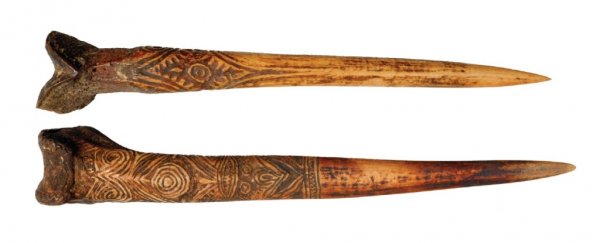If you are looking to make a bone dagger - and come on, who isn't - scientists have your back.
In a slightly creepy study, they've examined the structural properties of several and determined that the creme de la creme are those made out of human thigh bones.
Bone daggers are a common tool among the people of the Pacific Island of Papua New Guinea. They are often carved with decorative patterns, and used for hunting, fighting, and ceremonial purposes - and as a symbol of status and masculine fighting ability.
Usually, they are made of the thigh bone of the cassowary, a large (and very aggressive) flightless bird - but once upon a time, some were made from human bones.
These, according to researchers led by Dartmouth College in the US, were made from the thigh bones of respected men, and carried with them a special layer of prestige.
And, based on a study of 11 bone daggers - five human, made by the people of the Sepik region, six cassowary - the ones that used to be human thighs are stronger.
 (Nathaniel Dominy)
(Nathaniel Dominy)
"We used computed tomography to examine the structural mechanics of 11 bone daggers, 10 of which are museum-accessioned objects of art," the researchers wrote in their paper.
"We found that human and cassowary bones have similar material properties and that the geometry of human bone daggers results in higher moments of inertia and a greater resistance to bending.
"Data from finite-element models corroborated the superior mechanical performance of human bone daggers, revealing greater resistance to larger loads with fewer failed elements."
Although most of the daggers were owned by the college's Hood Museum of Art and therefore could not be put under mechanical stress, the team purchased a 1970s cassowary dagger from a private art dealer on which they could perform tests.
To simulate what would happen when a cassowary dagger is inserted into a human joint, the researchers embedded 20 percent of its length in a urethane casting. They then use a machine to push down on it until it broke, using that amount of force to establish a failure point.
They also used the broken pieces to make dog-bone samples to test the tensile strength of the bone.
 3D reconstructions of the daggers from CT scans. (Nathaniel Dominy)
3D reconstructions of the daggers from CT scans. (Nathaniel Dominy)
For the remaining 10 daggers, the team created CT scans of all of them, then converted them into models on which they could run simulations of mechanical stress.
They found that the human bones and the cassowary bones actually have very similar mechanical properties.
However, the human bone daggers were able to withstand higher stress - a property the researchers attributed to the shape of the human daggers, compared to the cassowary daggers.
The human daggers had been carved into a greater curvature - the flatter cross-sectional shape of the cassowary daggers is a weaker structure.
"We conclude," the researchers wrote, "by suggesting that people in the Sepik region of New Guinea engineered human bone daggers to withstand breakage, and that their prevailing motivation was to preserve intact the embodiment of symbolic strength and social prestige, an outcome that agrees well with the predictions of signalling theory."
The paper has been published in the journal Royal Society Open Science.
